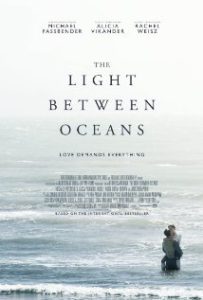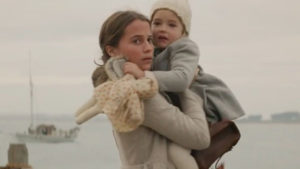 In terms of storytelling, director Derek Cainfrance is a novelist. The journey through The Light Between Oceans is careful, sometimes excruciating. It lingers over moments, drawing them open with beautiful images rather than words so that the shifts between them are deeply felt. At times, these pauses seem unnecessarily long and indulgent, but they are essential to the ultimate pay-off. In retrospect, each window into the lives of these characters is crafted to explore motive and offer understanding for the ones that follow in chronology. This can be appreciated most by a viewer who is prepared to enjoy a story that blooms rather than springs open. This slow-burn narrative can be a shock to the system of those used to a flashy, fluffy, fast-paced culture of entertainment, but how appropriate for the film to reflect the very human pace of the people and relationships on which it focuses.
In terms of storytelling, director Derek Cainfrance is a novelist. The journey through The Light Between Oceans is careful, sometimes excruciating. It lingers over moments, drawing them open with beautiful images rather than words so that the shifts between them are deeply felt. At times, these pauses seem unnecessarily long and indulgent, but they are essential to the ultimate pay-off. In retrospect, each window into the lives of these characters is crafted to explore motive and offer understanding for the ones that follow in chronology. This can be appreciated most by a viewer who is prepared to enjoy a story that blooms rather than springs open. This slow-burn narrative can be a shock to the system of those used to a flashy, fluffy, fast-paced culture of entertainment, but how appropriate for the film to reflect the very human pace of the people and relationships on which it focuses.
Arkapaw’s cinematography is gorgeous–the color palette and use of light reflecting the film’s very spiritual exploration of light against darkness. And the performances in the film are well rendered, populating the film with nuanced, believable characters: Vikander’s Isabel and Weisz’s Hannah chief among them.
The Light Between Oceans is a deliberate, visual, visceral story about grace—and I don’t just mean the little girl Grace who is a central figure. No, this story is about the grace that draws together what has been torn asunder, repairs impossible brokenness, defies understanding, and lavishes itself on even the most lost soul.
A romantic period drama, this film is brimming with such souls: the prejudiced father who rejects a beloved daughter; the war veteran plagued with guilt; the bright girl transformed into a desperate woman; and the wronged widow who must choose between resentment and forgiveness. Without warning or even request, grace enters into each of these lives in the form of an innocent little girl.
This is particularly true of Tom and Isabel Sherbourne. Tragedy leaves them desperate for grace, and it comes to them lavishly, drawing them together at the time when they are most fractured. However, rather than letting its power shape, grow, and change them, they try to manipulate and take control of its presence in their lives. In the process, they find themselves emptier and needier rather than satiated. Though grace does not abandon them, it is only in the Sherbourne’s surrender of self that grace is able to do its true, lasting work in their lives. And this comes not a moment too soon.
 The character of grace is slowly and fully revealed over the course of the story. It is by definition an external force–active, not passive. It cannot be shaped by human hands but rather, shapes that which it encounters. It is a gift that gives selflessly, continuously, and indiscriminately. And it is powerful. Indeed, through the film’s characters, circumstances, choices, and relationships, we are given a front row seat to the transforming power of grace on the willing heart. It is the light that guides, connecting oceans in which souls would otherwise be easily lost.
The character of grace is slowly and fully revealed over the course of the story. It is by definition an external force–active, not passive. It cannot be shaped by human hands but rather, shapes that which it encounters. It is a gift that gives selflessly, continuously, and indiscriminately. And it is powerful. Indeed, through the film’s characters, circumstances, choices, and relationships, we are given a front row seat to the transforming power of grace on the willing heart. It is the light that guides, connecting oceans in which souls would otherwise be easily lost.
The Light Between Oceans offers a very human story which unapologetically mirrors the human existence: a balance between darkness (tragedy, confusion, death, inexplicable life events, and the enduring consequences of personal choice) and light (breathtaking beauty, joy, and wonder). Perhaps it is the film’s relentless picture of pain, grief, and man’s capacity for evil that makes its themes of beauty and forgiveness so vivid and meaningful.

